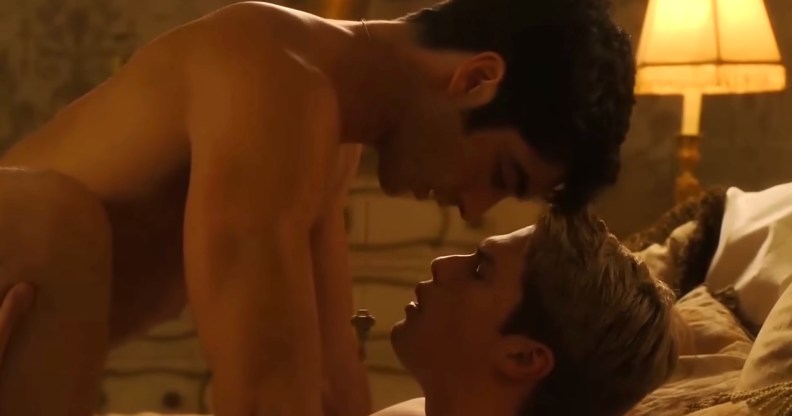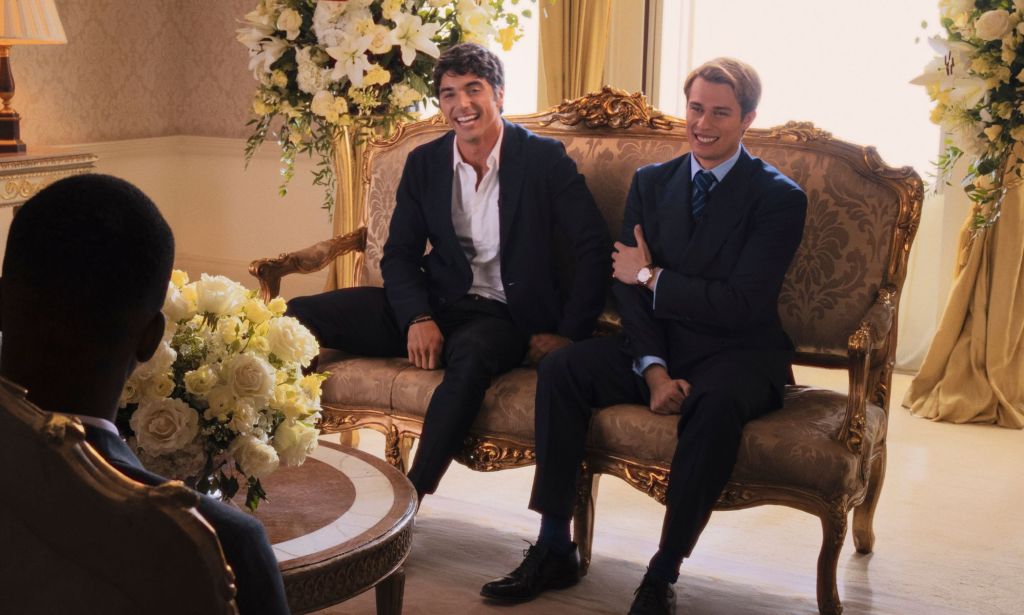‘Gay guys can do missionary?’ How Red, White & Royal Blue brings queer intimacy to the mainstream

Red, White & Royal Blue marks another milestone in depicting gay physical intimacy on screen. (Prime Video)
Red, White & Royal Blue marks another milestone in depicting gay physical intimacy on screen. (Prime Video)
The hit romantic comedy Red, White & Royal Blue, an adaptation of Casey McQuiston’s book of the same name, quickly became the number one movie on Prime.
The film follows Alex Claremont-Diaz (the son of the US president) and Prince Henry (the “spare” to the British royal throne) and their enemies-to-lovers secret romance, and its mainstream appeal broadens understandings of what gay intimacy can look like.
Red, White & Royal Blue is an exciting catalyst for new discussions between mainstream and queer audiences about gay representations in the media, portrayals of gay and queer sex in Hollywood cinema and the role media plays in how broader communities understand queer lives.
It takes on aspects of the gay rom-com genre that emerged through queer film festivals. And like other recent gay rom-coms that pitched to the mainstream, it takes on a role to explain gay contexts to non-queer audiences.
Gay cultural anxieties in the heterosexual setting
Red, White & Royal Blue takes steps to reflect aspects the gay context to both queer and mainstream audiences.
Upon coming out to his mother (President Ellen Claremont), Alex is met with a parent well-versed in current queer community matters. She reflects a growing broader community understanding of LGBTIQ+ community interests and anxieties.
As Alex makes clear he is bisexual, she responds “you know the B in LGBTQ is not a silent letter.” This reflection and acknowledgement of bi erasure (the questioning or denying the existence of bisexuality) may seem basic to those within the community. But it is a reminder to the audience that one half of this gay rom-com is bisexual.
The president also raises the prospect of going on Truvada, a medication that can help prevent HIV infection, even though the drug continues to have low awareness, even among primary care providers.
These – somewhat clunky, although I suspect that’s for comic effect – parental interjections provide aspects of the film’s establishment of gay contexts in a much more mainstream world.
However, it is the intimate portrayal of Alex and Henry’s first time having sex that is reflexive of queer community frustrations about gay sex in cinema. Director Matthew López addresses this matter directly in an interview with Digital Spy’s David Opie, saying: “I really wanted to show something that I hadn’t seen much of in mainstream movie making, which is sex between two men that is loving and connected, and that is emotionally resonant.”
The influence of queer film festivals
In my recent essay in Senses of Cinema, I argue that the gay rom-com emerged through the influence of queer film festivals.
Queer film festivals seek to give queer audiences stories where they can see themselves and their community. The growing global network of queer film festivals has also made them curators of what films are culturally valuable.
Think gay rom-coms like Bear City (2010), which premiered and circulated through queer film festivals, and reflects the physical spaces and cultural anxieties of New York’s bear subculture. The film shows a range of gay sex scenes with different levels of intimacy (although none quite as intimate as Red, White & Royal Blue).
In another genre, the gay romantic drama, Shelter (2007), which premiered at the 31st Frameline (LGBTQ+) film festival, is also an example that shows more variety and intimacy in representations of gay sex.
But Red, White & Royal Blue takes a mainstream setting, and pitches it to a mainstream audience. And yet, that’s not to say that there aren’t gay cultural contexts in the film.

Gay sex in Hollywood cinema
Film historian Vito Russo’s book Celluloid Closet: Homosexuality in the Movies charts gay and lesbian representations in cinema through the suppressive Hays Code era, which censored American films, and its impact through to the 1980s.
Russo argues that after years of suppression of gay and lesbian representations in Hollywood, the 1960s and 1970s saw a push by the mainstream to show limited views of gays onscreen. Russo describes “the readily visible poles of the gay community.” That is, “the sissy at one end” – the misoginistic framing of gay men as feminine the therefore weak – and “the leather-jacketed macho violence of the waterfront sex bar at the other”, portraying gay men as deviant and predatory.
One of the most graphic early depictions of gay sex in Hollywood cinema is in Fortune and Men’s Eyes (1971), with an infamous and confronting prison rape. In relation to gay sex scenes, such as in this film, Russo describes situational homosexuality as “either active (masculine and powerful) or passive (feminine and powerless)”.
There are many portrayals of gay sex in cinema, but this dynamic of gay sex as being about dominance of one man over another has persisted in many Hollywood representations. It is important to say this positioning is not an invalid portrayal of gay sex. But as with any stereotype, it is rooted in a history of showing gay men in a particular way.
My Policeman (2022), The Normal Heart (2014), Brokeback Mountain (2005) and Wet Hot American Summer (2001) are just a few recent examples of this representation of gay sex as an act of domination.
It is a portrayal so prominent that some outsiders to queer communities were surprised to see face-to-face gay sex in this latest gay rom-com. One Twitter poster asking “gay guys can do missionary?”. This has led to gay men on the social media platform noting the importance of gay representation in the media, and reviews, critique and media praising the “accuracy” of the scene.
The development of gay sex in Hollywood cinema is something to keep watching as these stories continue to find mainstream appeal.![]()
Damien O’Meara is a PhD Candidate in Media and Communications at Swinburne University of Technology.
This article is republished from The Conversation under a Creative Commons license. Read the original article.

